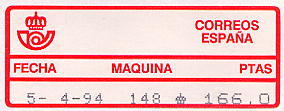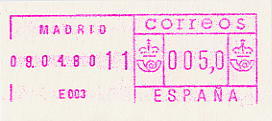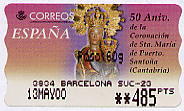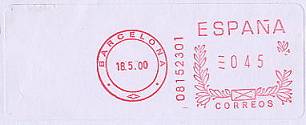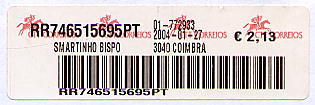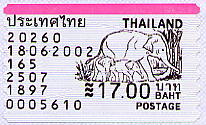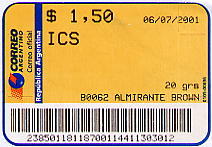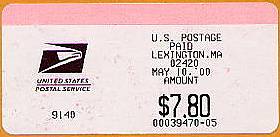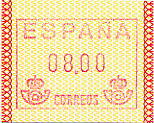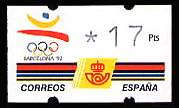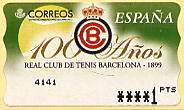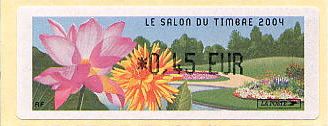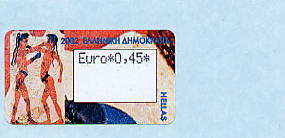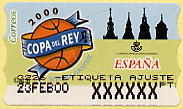What are the ATMs ? | How to collect them | The ATM catalogues
In the last decades many postal administrations around the world have tested, developed and implemented different franking solutions for shipments, using the issue of variable value stamps. Without doubt this is one of the fields in recent postal and philatelic history with more new ideas and even greater possibilities for the future, and also one of the most unacknowledged amongst philatelists. In this article we'll develop what makes a variable value stamp and its classification.
Any postage stamp not meeting these requirements cannot be considered a variable value stamp. The variable value stamps (or automatic variable value stamps) can be described using different criteria, although the main one is possibly according to their conditions of issue and use. They could be also classified, for example, according to the characteristics of the paper when they are printed. According to the conditions of use of the postage stamp, the variable value stamps can be classified as stamps for immediate use and stamps with indefinite validity (ATMs). In the first case, they are postage stamps issued by the postal employees for franking postal items handed in at the Post Office window, or by the user with special equipment (self-service vending machines or personal computer), and their use and expiry are immediate. These stamps always include some data (sometimes using 2D matrix codes) about the post office origin or issuing equipment, or even the sender or user, and the date of issue. The date is used as a postmark, so these stamps do not require any type of postal cancellation.
These stamps are known amongst international collectors by a variety of names: meter stamps, SFS (from the German word Schalterfreistempel or counter stamp), vignettes de guichet, TP label, etc.. In recent years new systems of immediate franking using the Internet and personal computers have been and are being implemented in some countries. These are known as PC franking or PC postage. (More information: The variable value stamps for immediate use in the world- Spanish version only) This type of stamp can sometimes be printed on a special security paper, either gummed or self-adhesive, to be affixed, after issue, onto the shipment, or printed directly onto the envelope. In Spain these postage stamps are known as franqueos mecánicos (mechanical frankings).
On the other hand there are variable value stamps with indefinite validity which we know as ATMs, issued for public use from automatic self-service vending machines or counter machines by the employees in the post offices, depending on the country. These machines instantly print the face value required, as selected by the user onto a special paper or label, (gummed or self-adhesive), and usually with a preprinted security background, and the resulting stamp has the same characteristics and can be used for franking just as a "traditional" stamp - anytime and anywhere. It has indefinite validity until affixed and postally cancelled. ATMs can be bought by anyone for use at anytime. Likewise some types of PC-stamps can be used anytime and anywhere, but only by the user or owner of the specific computer software. They are then no longer treated neither as traditional stamps nor ATMs.
In the first instance, ATMs differ from the mechanical franking because they don't have a date printed on them, which makes for open ended usage, and always requires postal cancellation when finally used for franking. Having said this, there are exceptions. There are ATM issues which include the date of purchase. Whether a product can be called an ATM is not decided just by the appearance, but the application and the official attitude by the postal administration, concerning the conditions for their use and validity. If the issue can be used anywhere in the country at any time, it's an ATM. If its use, as a stamp, is limited to the date and place of issue, it is not an ATM. A frequent error is to use the denomination of ATM or variable value stamps by reference to the paper or label. An ATM is not determined by the paper on which it is printed, but the resulting postage stamp. In the case of Spain, for example, there exists some special printings like adjust and control labels, and these are neither stamps nor ATMs !
ATMs started in 1969 with some tests with a vending machine SAFAA-SATAS in Montgeron, France, and are fully recognized as valid stamps by the U.P.U., according to the resolution of the Hamburg Congress in 1984.
This method of franking is used in many countries world wide. These stamps are known by a variety of names -sello automático, estampilla, etiquette de distributeur, vignette d'affranchissement, machine vending stamp, CVP - Computer vended postage, automatic stamp, francobolli automatici, ...-, but the most widely used term is ATM (an abbreviation of the German term "Automatenmarken" or stamp from an automatic machine). (More information: The world of ATMs)
In the same way, some of the world wide definitive series with an identical design and different face values are not variable value stamps.
© J. Jove - M. Sans. ATEEME. Variable value stamps study group. All rights reserved This page was created in 1999 and last updated: 22.06.06 . English edition rewrited by S. Goodman (22.06.06) |
||||||||||||||||||||||||||||||||||||||||||
